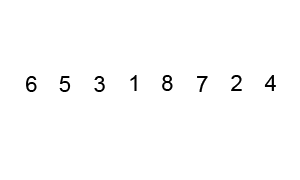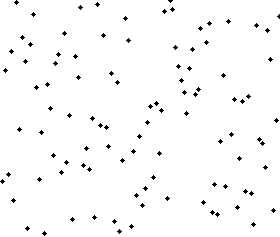|
Bubblesort
Bubble sort, sometimes referred to as sinking sort, is a simple sorting algorithm that repeatedly steps through the input list element by element, comparing the current element with the one after it, Swap (computer science), swapping their values if needed. These passes through the list are repeated until no swaps have to be performed during a pass, meaning that the list has become fully sorted. The algorithm, which is a comparison sort, is named for the way the larger elements "bubble" up to the top of the list. It performs poorly in real-world use and is used primarily as an educational tool. More efficient algorithms such as quicksort, timsort, or merge sort are used by the sorting libraries built into popular programming languages such as Python and Java. History The earliest description of the bubble sort algorithm was in a 1956 paper by mathematician and actuary Edward Harry Friend, ''Sorting on electronic computer systems'', published in the third issue of the third volume ... [...More Info...] [...Related Items...] OR: [Wikipedia] [Google] [Baidu] |
Sorting Algorithm
In computer science, a sorting algorithm is an algorithm that puts elements of a List (computing), list into an Total order, order. The most frequently used orders are numerical order and lexicographical order, and either ascending or descending. Efficient sorting is important for optimizing the Algorithmic efficiency, efficiency of other algorithms (such as search algorithm, search and merge algorithm, merge algorithms) that require input data to be in sorted lists. Sorting is also often useful for Canonicalization, canonicalizing data and for producing human-readable output. Formally, the output of any sorting algorithm must satisfy two conditions: # The output is in monotonic order (each element is no smaller/larger than the previous element, according to the required order). # The output is a permutation (a reordering, yet retaining all of the original elements) of the input. Although some algorithms are designed for sequential access, the highest-performing algorithms assum ... [...More Info...] [...Related Items...] OR: [Wikipedia] [Google] [Baidu] |
Pseudocode
In computer science, pseudocode is a description of the steps in an algorithm using a mix of conventions of programming languages (like assignment operator, conditional operator, loop) with informal, usually self-explanatory, notation of actions and conditions. Although pseudocode shares features with regular programming languages, it is intended for human reading rather than machine control. Pseudocode typically omits details that are essential for machine implementation of the algorithm, meaning that pseudocode can only be verified by hand. The programming language is augmented with natural language description details, where convenient, or with compact mathematical notation. The reasons for using pseudocode are that it is easier for people to understand than conventional programming language code and that it is an efficient and environment-independent description of the key principles of an algorithm. It is commonly used in textbooks and scientific publications to document ... [...More Info...] [...Related Items...] OR: [Wikipedia] [Google] [Baidu] |
Odd–even Sort
In computing, an odd–even sort or odd–even transposition sort (also known as brick sort or parity sort) is a relatively simple sorting algorithm, developed originally for use on parallel processors with local interconnections. It is a comparison sort related to bubble sort, with which it shares many characteristics. It functions by comparing all odd/even indexed pairs of adjacent elements in the list and swapping pairs where in the wrong order (where the first is larger than the second). The next step repeats this for even/odd indexed pairs (of adjacent elements). Then it alternates between odd/even and even/odd steps until the list is sorted. Sorting on processor arrays On parallel processors, with one value per processor and only local left–right neighbor connections, the processors all concurrently do a compare–exchange operation with their neighbors, alternating between odd–even and even–odd pairings. This algorithm was originally presented, and shown to be eff ... [...More Info...] [...Related Items...] OR: [Wikipedia] [Google] [Baidu] |
Selection Sort
In computer science, selection sort is an in-place comparison sorting algorithm. It has a O(''n''2) time complexity, which makes it inefficient on large lists, and generally performs worse than the similar insertion sort. Selection sort is noted for its simplicity and has performance advantages over more complicated algorithms in certain situations, particularly where auxiliary memory is limited. The algorithm divides the input list into two parts: a sorted sublist of items which is built up from left to right at the front (left) of the list and a sublist of the remaining unsorted items that occupy the rest of the list. Initially, the sorted sublist is empty and the unsorted sublist is the entire input list. The algorithm proceeds by finding the smallest (or largest, depending on sorting order) element in the unsorted sublist, exchanging (swapping) it with the leftmost unsorted element (putting it in sorted order), and moving the sublist boundaries one element to the right. T ... [...More Info...] [...Related Items...] OR: [Wikipedia] [Google] [Baidu] |
Java (programming Language)
Java is a High-level programming language, high-level, General-purpose programming language, general-purpose, Memory safety, memory-safe, object-oriented programming, object-oriented programming language. It is intended to let programmers ''write once, run anywhere'' (Write once, run anywhere, WORA), meaning that compiler, compiled Java code can run on all platforms that support Java without the need to recompile. Java applications are typically compiled to Java bytecode, bytecode that can run on any Java virtual machine (JVM) regardless of the underlying computer architecture. The syntax (programming languages), syntax of Java is similar to C (programming language), C and C++, but has fewer low-level programming language, low-level facilities than either of them. The Java runtime provides dynamic capabilities (such as Reflective programming, reflection and runtime code modification) that are typically not available in traditional compiled languages. Java gained popularity sh ... [...More Info...] [...Related Items...] OR: [Wikipedia] [Google] [Baidu] |
Branch Predictor
In computer architecture, a branch predictor is a digital circuit that tries to guess which way a branch (e.g., an if–then–else structure) will go before this is known definitively. The purpose of the branch predictor is to improve the flow in the instruction pipeline. Branch predictors play a critical role in achieving high performance in many modern pipelined microprocessor architectures. Two-way branching is usually implemented with a conditional jump instruction. A conditional jump can either be "taken" and jump to a different place in program memory, or it can be "not taken" and continue execution immediately after the conditional jump. It is not known for certain whether a conditional jump will be taken or not taken until the condition has been calculated and the conditional jump has passed the execution stage in the instruction pipeline (see fig. 1). Without branch prediction, the processor would have to wait until the conditional jump instruction has passed the ... [...More Info...] [...Related Items...] OR: [Wikipedia] [Google] [Baidu] |
The Art Of Computer Programming
''The Art of Computer Programming'' (''TAOCP'') is a comprehensive multi-volume monograph written by the computer scientist Donald Knuth presenting programming algorithms and their analysis. it consists of published volumes 1, 2, 3, 4A, and 4B, with more expected to be released in the future. The Volumes 1–5 are intended to represent the central core of computer programming for sequential machines; the subjects of Volumes 6 and 7 are important but more specialized. When Knuth began the project in 1962, he originally conceived of it as a single book with twelve chapters. The first three volumes of what was then expected to be a seven-volume set were published in 1968, 1969, and 1973. Work began in earnest on Volume 4 in 1973, but was suspended in 1977 for work on typesetting prompted by the second edition of Volume 2. Writing of the final copy of Volume 4A began in longhand in 2001, and the first online pre-fascicle, 2A, appeared later in 2001. The first published installment ... [...More Info...] [...Related Items...] OR: [Wikipedia] [Google] [Baidu] |
Donald Knuth
Donald Ervin Knuth ( ; born January 10, 1938) is an American computer scientist and mathematician. He is a professor emeritus at Stanford University. He is the 1974 recipient of the ACM Turing Award, informally considered the Nobel Prize of computer science. Knuth has been called the "father of the analysis of algorithms". Knuth is the author of the multi-volume work '' The Art of Computer Programming''. He contributed to the development of the rigorous analysis of the computational complexity of algorithms and systematized formal mathematical techniques for it. In the process, he also popularized the asymptotic notation. In addition to fundamental contributions in several branches of theoretical computer science, Knuth is the creator of the TeX computer typesetting system, the related METAFONT font definition language and rendering system, and the Computer Modern family of typefaces. As a writer and scholar, Knuth created the WEB and CWEB computer programming systems des ... [...More Info...] [...Related Items...] OR: [Wikipedia] [Google] [Baidu] |
Bogosort
In computer science, bogosort (also known as permutation sort and stupid sort) is a sorting algorithm based on the generate and test paradigm. The function successively generates permutations of its input until it finds one that is sorted. It is not considered useful for sorting, but may be used for educational purposes, to contrast it with more efficient algorithms. The algorithm's name is a portmanteau of the words ''bogus'' and ''sort''. Two versions of this algorithm exist: a deterministic version that enumerates all permutations until it hits a sorted one,. and a randomized version that randomly permutes its input and checks whether it is sorted. An analogy for the working of the latter version is to sort a deck of cards by throwing the deck into the air, picking the cards up at random, and repeating the process until the deck is sorted. In a worst-case scenario with this version, the random source is of low quality and happens to make the sorted permutation unlikely to o ... [...More Info...] [...Related Items...] OR: [Wikipedia] [Google] [Baidu] |
Jargon File
The Jargon File is a glossary and usage dictionary of slang used by computer programmers. The original Jargon File was a collection of terms from technical cultures such as the MIT Computer Science and Artificial Intelligence Laboratory, MIT AI Lab, the Stanford University centers and institutes#Stanford Artificial Intelligence Laboratory, Stanford AI Lab (SAIL) and others of the old ARPANET Artificial intelligence, AI/Lisp programming language, LISP/PDP-10 communities, including BBN Technologies, Bolt, Beranek and Newman (BBN), Carnegie Mellon University, and Worcester Polytechnic Institute. It was published in paperback form in 1983 as ''The Hacker's Dictionary'' (edited by Guy L. Steele Jr., Guy Steele) and revised in 1991 as ''The New Hacker's Dictionary'' (ed. Eric S. Raymond; third edition published 1996). The concept of the file began with the Tech Model Railroad Club (TMRC) that came out of early TX-0 and PDP-1 hackers in the 1950s, where the term ''hacker'' emerged and the ... [...More Info...] [...Related Items...] OR: [Wikipedia] [Google] [Baidu] |
Owen Astrachan
Owen Astrachan is an American computer scientist and professor of the practice of computer science at Duke University, where he is also the department's director of undergraduate studies. He is known for his work in curriculum development and methods of teaching computer science. He was one of the first National Science Foundation CISE Distinguished Education Fellows, and is a recipient of the Association for Computing Machinery, ACM Outstanding Educator Award. He was the principal investigator on the multi-year NSF/College Board project that led to the release of the AP Computer Science Principles course and exam. Early life Astrachan was born in New York City in 1956 to Gail Lovejoy and Anthony Astrachan. He has a younger brother, Joshua Astrachan. Education and early career Astrachan graduated from Dartmouth College in 1978 with an Bachelor of Arts, AB degree in mathematics. He received a Master of Arts in Teaching from Duke in 1979, doing his initial teaching at Lejeune High ... [...More Info...] [...Related Items...] OR: [Wikipedia] [Google] [Baidu] |





